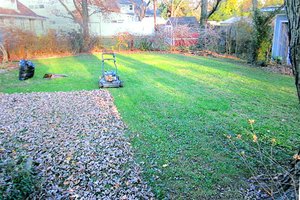 Skip the rake and attach a mulching blade to your mower. The shredded leaves will protect and feed your lawn during winter.
Skip the rake and attach a mulching blade to your mower. The shredded leaves will protect and feed your lawn during winter.
Although spring lawn care gets all the attention, fall lawn care is the make-it or break-it season for grass.
“I’m already thinking about next year,” says John Dillon, who takes care of New York City’s Central Park, which features 200 acres of lawn in the middle of Manhattan. “The grass I grow this fall is what will be there next spring.”
Fall lawn care is no walk in the park. It’s hard work, and Dillon guides you through the four basic steps.
1. Aeration
Aeration gives your lawn a breather in autumn and provides room for new grass to spread without competition from spring weeds. Aeration tools pull up plugs of grass and soil, breaking up compacted turf. That allows water, oxygen, and nutrients to reach roots, and gives seeds room to sprout.
If kids frequently play on your lawn, plan to aerate twice a year — fall and spring. If your lawn is just for show, then aerate once a year — and maybe even once every other year.
A hand-aerating tool ($20), which looks like a pitchfork with hollow tines, is labor-intensive and meant for unplugging small sections of grass. Gas-powered aerating machines (rental, $20/hour) are about the size of a big lawn mower, and are good for working entire lawns. Bring some muscle when you pick up your rental: Aerating machines are heavy and can be hard to lift into your truck or SUV.
Depending on the size of your property, professional aeration costs about $150.
2. Seeding
Fall, when the soil temperature is about 55 degrees, is the best time to seed your lawn because turf roots grow vigorously in fall and winter. If you want a lush lawn, don’t cheap out on the seed.
Bags of inexpensive seed ($35 for 15 pounds) often contain hollow husks, weed seed, and annual rye grass seed, which grows until the first frost then drops dead. Splurge on the good stuff ($55 for 15 pounds of Kentucky Bluegrass seed), which resists drought, disease, and insects.
Water your new seed every day for 10 to 20 days until it germinates.
3. Fertilizing
A late fall fertilization — before the first frost — helps your grass survive a harsh winter and encourages it to grow green and lush in spring. Make your last fertilization of the year count by choosing a product high (10% to 15%) in phosphorous, which is critical for root growth, Dillon says.
Note: Some states are banning phosphorous-rich fertilizers, which are harmful to the watershed. In those places, look for nitrogen-rich fertilizers, which promote shoot and root growth. Check with your local extension service to see what regulations apply in your area.
4. Mulching
Instead of raking leaves, run over them a couple of times with your mower to grind them into mulch. The shredded leaves protect grass from winter wind and desiccation. An added bonus — shredded leaves decompose into yummy organic matter to feed grass roots.
A mulching blade ($10) that attaches to your mower will grind the leaves even finer.
Article Shared from HouseLogic
Image: Paul Balze

No Comments